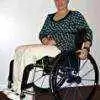-
Welcome to Celiac.com!
You have found your celiac tribe! Join us and ask questions in our forum, share your story, and connect with others.
-
Celiac.com Sponsor (A1):
Celiac.com Sponsor (A1-M):
-
Get Celiac.com Updates:Support Our Content
Celiac Disease, Gluten Ataxia And Candidiasis / Yeast Overgrowth - A Must Read!
-
Get Celiac.com Updates:Support Celiac.com:
-
Celiac.com Sponsor (A17):
Celiac.com Sponsor (A17):
Celiac.com Sponsors (A17-M):
-
Recent Activity
-
- Scott Adams replied to Jmartes71's topic in Coping with Celiac Disease1
Taken Seriously
Your post demonstrates the profound frustration and isolation that so many in the Celiac community feel, and I want to thank you for channeling that experience into advocacy. The medical gaslighting you endured for decades is an unacceptable and, sadly, a common story, and the fact that you now have to "school" your own GI specialist speaks volumes about... -
- Scott Adams replied to ckeyser88's topic in Introduce Yourself / Share Stuff1
Looking for a gluten-free roomie in Denver CO
I had no idea there is a "Louisville" in Colorado!😉 I thought it was a typo because I always think of the Kentucky city--but good luck! -
- Scott Adams replied to ElisaAllergiesgluten's topic in Gluten-Free Foods, Products, Shopping & Medications1
Allergy medication: cetirizine by the HealthA2Z is it gluten free?
Navigating medication safety with Celiac disease can be incredibly stressful, especially when dealing with asthma and severe allergies on top of it. While I don't have personal experience with the HealthA2Z brand of cetirizine, your caution is absolutely warranted. The inactive ingredients in pills, known as excipients, are often where gluten can be hidden... -
- Scott Adams replied to Jsingh's topic in Food Intolerance & Leaky Gut1
Protein or fat?
What you're describing is indeed familiar to many in the Celiac community, especially in the early stages of healing. When the intestinal villi are damaged from Celiac disease, they struggle to properly digest and absorb fats, a condition known as bile acid malabsorption. This can cause exactly the kind of cramping and spasms you're seeing, as undigested... -
- Beverage replied to MegRCxx's topic in Post Diagnosis, Recovery & Treatment of Celiac Disease2
Diagnosed celiac for 1-2 months ago and everything makes me bloated.
I had a very rough month after diagnosis. No exaggeration, lost so much inflammatory weight, I looked like a bag of bones, underneath i had been literally starving to death. I did start feeling noticeably better after a month of very strict control of my kitchen and home. What are you eating for breakfast and lunch? I ignored my doc and ate oats...
-




Recommended Posts
Archived
This topic is now archived and is closed to further replies.